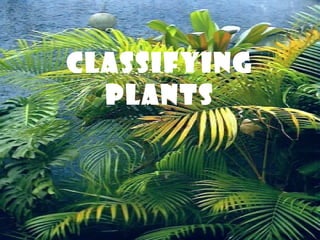Vascular nonvascular plants
•Download as PPT, PDF•
11 likes•24,739 views
Report
Share
Report
Share

Recommended
Recommended
More Related Content
What's hot
What's hot (20)
Similar to Vascular nonvascular plants
Similar to Vascular nonvascular plants (20)
5 1-pharmacognostical profile of selected medicinal plants

5 1-pharmacognostical profile of selected medicinal plants
More from CDA-PamelaOrtiz
More from CDA-PamelaOrtiz (20)
Recently uploaded
Making communications land - Are they received and understood as intended? webinar
Thursday 2 May 2024
A joint webinar created by the APM Enabling Change and APM People Interest Networks, this is the third of our three part series on Making Communications Land.
presented by
Ian Cribbes, Director, IMC&T Ltd
@cribbesheet
The link to the write up page and resources of this webinar:
https://www.apm.org.uk/news/making-communications-land-are-they-received-and-understood-as-intended-webinar/
Content description:
How do we ensure that what we have communicated was received and understood as we intended and how do we course correct if it has not.Making communications land - Are they received and understood as intended? we...

Making communications land - Are they received and understood as intended? we...Association for Project Management
https://app.box.com/s/7hlvjxjalkrik7fb082xx3jk7xd7liz3TỔNG ÔN TẬP THI VÀO LỚP 10 MÔN TIẾNG ANH NĂM HỌC 2023 - 2024 CÓ ĐÁP ÁN (NGỮ Â...

TỔNG ÔN TẬP THI VÀO LỚP 10 MÔN TIẾNG ANH NĂM HỌC 2023 - 2024 CÓ ĐÁP ÁN (NGỮ Â...Nguyen Thanh Tu Collection
Mehran University Newsletter is a Quarterly Publication from Public Relations OfficeMehran University Newsletter Vol-X, Issue-I, 2024

Mehran University Newsletter Vol-X, Issue-I, 2024Mehran University of Engineering & Technology, Jamshoro
Recently uploaded (20)
Food safety_Challenges food safety laboratories_.pdf

Food safety_Challenges food safety laboratories_.pdf
Python Notes for mca i year students osmania university.docx

Python Notes for mca i year students osmania university.docx
Unit-V; Pricing (Pharma Marketing Management).pptx

Unit-V; Pricing (Pharma Marketing Management).pptx
Making communications land - Are they received and understood as intended? we...

Making communications land - Are they received and understood as intended? we...
Micro-Scholarship, What it is, How can it help me.pdf

Micro-Scholarship, What it is, How can it help me.pdf
On National Teacher Day, meet the 2024-25 Kenan Fellows

On National Teacher Day, meet the 2024-25 Kenan Fellows
TỔNG ÔN TẬP THI VÀO LỚP 10 MÔN TIẾNG ANH NĂM HỌC 2023 - 2024 CÓ ĐÁP ÁN (NGỮ Â...

TỔNG ÔN TẬP THI VÀO LỚP 10 MÔN TIẾNG ANH NĂM HỌC 2023 - 2024 CÓ ĐÁP ÁN (NGỮ Â...
UGC NET Paper 1 Mathematical Reasoning & Aptitude.pdf

UGC NET Paper 1 Mathematical Reasoning & Aptitude.pdf
General Principles of Intellectual Property: Concepts of Intellectual Proper...

General Principles of Intellectual Property: Concepts of Intellectual Proper...
Fostering Friendships - Enhancing Social Bonds in the Classroom

Fostering Friendships - Enhancing Social Bonds in the Classroom
Vascular nonvascular plants
- 2. Standards: Students will be able to demonstrate how plants are sorted into groups. • Essential Questions: How is the classification of plants and animals similar and different?
- 3. Vocabulary to Know • Botanist • Vascular plant • Nonvascular plant
- 4. Plants • Plants do not have fur, scales, or blood, so how are they classified? Like animals, plants are divided into two main groups. Then these two groups are divided into smaller groups. The ways that plants get their food and the ways that they create new plants will help you classify them.
- 5. Who studies plants? A botanist is a scientist who specializes in the study of plants. They classify plants based on their characteristics (vascular and nonvascular). You could call them “Plant Explorers.”
- 6. How are they classified? • One way that plants can be classified is by how they carry water. Plants can either be Vascular or Nonvascular. • Vascular means “having tubes” • Nonvascular mean “not having tubes”
- 7. Vascular Plant Plants that have tubes, roots, stems, and leaves. These plants stand up tall.
- 8. Why are these trees vascular? They have tubes, roots, stems, and leaves. They also stand up tall.
- 10. Nonvascular Plant roots, stems, Plants that do not have tubes, or leaves. These plants soak up water and food from the soil, like sponges. They are also much smaller than vascular plants.
- 11. Why is this an example of a Non-Vascular plant? Non-Vascular Plants have no roots, stems, or leaves. They also don’t have any tubes.
- 12. Vascular or Non-Vascular? Non-Vascular
- 13. Vascular or Non-Vascular? Vascular
- 14. Moss on the Tree: Vascular or Non-Vascular? Non-Vascular
- 15. Vascular or Non-Vascular? Vascular